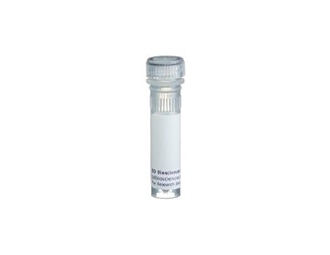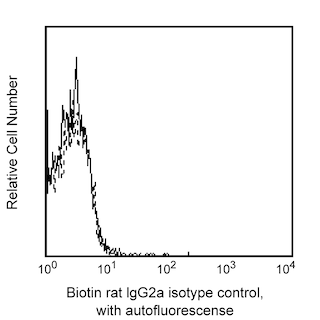-
Your selected country is
Middle East / Africa
- Change country/language
Old Browser
This page has been recently translated and is available in French now.
Looks like you're visiting us from {countryName}.
Would you like to stay on the current country site or be switched to your country?




Flow cytometric analysis of CD132 expression on human peripheral blood lymphocytes. Whole blood was stained with either Biotin Rat Anti-Human CD132 (Cat. No. 555896; solid line histogram) or Biotin Rat IgG2b, κ Isotype Control (Cat. No. 555847; dashed line histogram), followed by PE Streptavidin (Cat. No. 554061). Erythrocytes were lysed with BD Pharm Lyse™ Lysing Buffer (Cat. No. 349202). Fluorescent histograms depicting CD132 (or Ig isotype) expression were derived from gated events with the side and forward light-scattering characteristics of viable lymphocytes. Flow cytometry was performed on a BD FACScan™ system.


BD Pharmingen™ Biotin Rat Anti-Human CD132

Regulatory Status Legend
Any use of products other than the permitted use without the express written authorization of Becton, Dickinson and Company is strictly prohibited.
Preparation And Storage
Product Notices
- Since applications vary, each investigator should titrate the reagent to obtain optimal results.
- An isotype control should be used at the same concentration as the antibody of interest.
- Caution: Sodium azide yields highly toxic hydrazoic acid under acidic conditions. Dilute azide compounds in running water before discarding to avoid accumulation of potentially explosive deposits in plumbing.
- Species cross-reactivity detected in product development may not have been confirmed on every format and/or application.
- For fluorochrome spectra and suitable instrument settings, please refer to our Multicolor Flow Cytometry web page at www.bdbiosciences.com/colors.
- Please refer to http://regdocs.bd.com to access safety data sheets (SDS).
- Please refer to www.bdbiosciences.com/us/s/resources for technical protocols.
Companion Products

.png?imwidth=320)
The TUGh4 monoclonal antibody specifically binds to CD132. CD132 is a 65-70 kDa type 1 transmembrane glycoprotein that is encoded by the IL2RG (interleukin 2 receptor, gamma) gene. CD132 is also known as the common γ subunit (γc) and is shared by the IL-2, IL-4, IL-7, IL-9, IL-15 and IL-21 receptor complexes. CD132 is broadly expressed by most peripheral T and B lymphocytes, NK cells, monocytes, and granulocytes. The cytoplasmic domain of the γc chain plays an important role in cytokine-mediated signal transduction. Mutation of the IL2RG gene results in X-linked severe combined immunodeficiency (XSCID). The TUGh4 antibody recognizes a different epitope from that recognized by the CD132-specific clone, AG184.
Development References (6)
-
Guesdon JL, Ternynck T, Avrameas S. The use of avidin-biotin interaction in immunoenzymatic techniques. J Histochem Cytochem. 1979; 27(8):1131-1139. (Biology). View Reference
-
Ishii N, Kondo M, Takeshita T, and Sugamura K. mAb specific for the γ chain of the IL-2 receptor. In: Schlossman SF. Stuart F. Schlossman .. et al., ed. Leucocyte typing V : white cell differentiation antigens : proceedings of the fifth international workshop and conference held in Boston, USA, 3-7 November, 1993. Oxford: Oxford University Press; 1995:1867-1868.
-
Ishii N, Takeshita T, Kimura Y, et al. Expression of the IL-2 receptor gamma chain on various populations in human peripheral blood. Int Immunol. 1994; 6(8):1273-1277. (Biology). View Reference
-
Kishimoto T. Tadamitsu Kishimoto .. et al., ed. Leucocyte typing VI : white cell differentiation antigens : proceedings of the sixth international workshop and conference held in Kobe, Japan, 10-14 November 1996. New York: Garland Pub.; 1997.
-
Lin G-X, Yang X, Hollemweguer E, et al. Cross-reactivity of CD antibodies in eight animal species. In: Mason D. David Mason .. et al., ed. Leucocyte typing VII : white cell differentiation antigens : proceedings of the Seventh International Workshop and Conference held in Harrogate, United Kingdom. Oxford: Oxford University Press; 2002:519-523.
-
Matsuoka M, Takeshita T, Ishii N, Nakamura M, Ohkubo T, Sugamura K. Kinetic study of interleukin-2 binding on the reconstituted interleukin-2 receptor complexes including the human gamma chain. Eur J Immunol. 1993; 23(10):2472-2476. (Biology). View Reference
Please refer to Support Documents for Quality Certificates
Global - Refer to manufacturer's instructions for use and related User Manuals and Technical data sheets before using this products as described
Comparisons, where applicable, are made against older BD Technology, manual methods or are general performance claims. Comparisons are not made against non-BD technologies, unless otherwise noted.
For Research Use Only. Not for use in diagnostic or therapeutic procedures.
Report a Site Issue
This form is intended to help us improve our website experience. For other support, please visit our Contact Us page.